A Brief History
Discover the ancient origins and fascinating history of tea!
Tea is the most widely used ancient beverage in the world. Today, tea remains to be a popular drink of choice - helping us to hydrate, stay warm on a cold day or simply enjoy the taste of its different varieties. Alongside Black tea there are other tea varieties that we can also enjoy. Here are some facts about some of these:
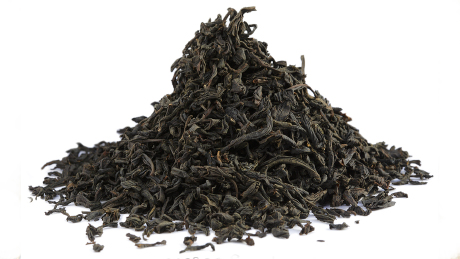
Perhaps the most famous china tea, the best coming from the hills in north Fujian. It is a unique large leaf tea distinguished by its smoky aroma and flavour. The tarry taste is acquired through drying over pine wood fires.
The legend about the origin of Lapsang Souchong is that the smoking process was discovered by accident. An army is said to have camped in a tea factory that was full of drying leaves which had to be moved to accommodate the soldiers. When the soldiers left, the leaves needed to be dried quickly, so the workers lit open fires of pinewood to speed up the drying. The tea reached the market on time and a new flavour had been created.
The real story about why these teas from Fujian province have a smoky flavour is that in the early 17th century when the Chinese tea producers began to export their teas to Europe and America, their traditional green teas did not travel well and quickly lost quality during the 15-18 month journey across land and sea. The producers developed a method of rolling, oxidising and drying their teas so that they would hold their quality for longer. Once the teas had been oxidised, they were spread on bamboo baskets which were placed on racks in the drying room. This was built over ovens that allowed the heat to rise up through vents in the ceiling and into the drying room above. To fire the ovens, the tea manufacturers used the local pine wood from the forests that surrounded (and still surround) the factories, and as the wood slowly burned, it gave off a certain amount of smoke that was absorbed by the drying tea and gave it a lightly smoked, sappy, pine character.
The factories that made those lightly smoked black teas in Fujian province still manufacture lightly smoked Lapsangs in exactly the same way as they did 400 years ago. The teas are often called Bohea Lapsangs - the term Bohea being a derivation of 'Wuyi', the name of the famous mountain area where these teas are made. They also manufacture the much smokier Lapsang Souchongs that are popular today.
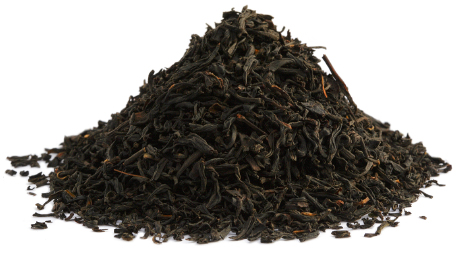
A popular black tea from Anhui Province, this is a 'gonfu' tea - which means that it is made with disciplined skill to produce the thin tight strips of leaf without breaking the leaves. The tight black leaves give a rich brown liquor, which has a lightly scented nutty flavour and delicate aroma.
A black tea from the province of Yunnan in the south west of China. It has a rich, earthy, malty flavour similar to Assam teas and is best drunk with milk. It makes an excellent breakfast tea.
Other recommended China black teas are Keemun Mao Feng (Hair Point) and Szechwan Imperial.
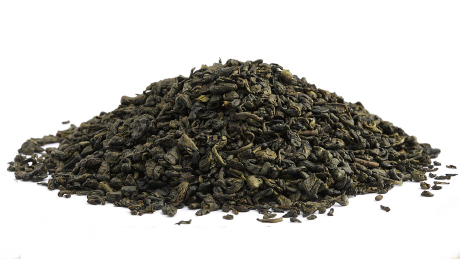
Most Gunpowder tea is produced in Pingshui in Zheijian Province. After it has been pan-fired to de-enzyme it, the leaf is rolled into small pellets and then dried. The pellets look remarkably like lead shot or gunpowder, giving the tea its descriptive name. The pellets come in different sizes - the smaller the leaf plucked and rolled, the smaller the pellet - and grades range from tiny 'pinhead' gunpowder to larger 'peahead' gunpowder. Gunpowder tea has a soft honey or coppery liquor with a herby smooth light taste.
Chun Mee literally means 'precious eyebrows' and the shape of the leaves give this tea its name. The processing of 'eyebrow' teas demands great skill in order to hand roll and dry the leaves to the correct shape at the right temperature for the correct length of time. These long, fine jade leaves give a clear, pale yellow liquor with a smooth taste.
Other green teas from China include Longjing (Dragon's Well) from Zheijiang; Taiping Hon Kui (Monkey King) from Anhui; and Youngxi Huo Qing (Firegreen).
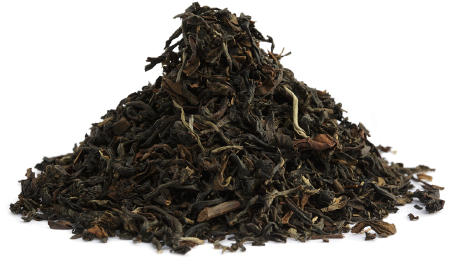
Traditionally from China's Fujian province and Taiwan, these are semi-oxidised teas that vary from greenish rolled oolongs (that give a light, floral liquor reminiscent of lily of the valley, narcissus, orchid or hyacinth) to dark brown leafed oolongs (that yield liquors with deeper, earthier flavours and lingering hints of peach and apricot).
These two distinct types of oolong are made by two very different processes.
To manufacture the darker leafed oolongs, the freshly plucked leaf is withered, then shaken or 'rattled' in bamboo baskets or in a bamboo tumbling machine to lightly bruise parts of the leaf, then oxidised for a short time so that the bruised parts of the leaf begin to oxidise. When 60-70% oxidation has been reached, the leaf is dried.
To manufacture the greener oolongs, the leaf is withered and then wrapped inside a large cloth and rolled in a special machine. The bag is then opened and the leaf is spread out briefly to oxidise lightly. The leaf is repeatedly wrapped, rolled and oxidised until approximately 30% oxidation has been achieved. The tea is then dried to remove all but 2-3% of the remaining water. The most famous of these greener, light, fragrant oolongs is Tie Kuan YIn which has a hyacinth or narcissus character.
All oolongs are better drunk without milk.
This is made in China's Fuijan province and in Taiwan. The name means 'Tea of the Iron Goddess of Mercy' who is said to have appeared in a dream to a local tea farmer, telling him to look in a cave behind her temple. There he found a single tea shoot that he planted and cultivated. The bush he grew is said to have been the parent bush from which cuttings have been grown and leaf plucked over the centuries to make this very fragrant tea. It is today one of the most sought after oolongs around the world.
Other recommended China oolong teas are Fonghwang Tan-chung, Shui Hsien (Water Sprite), Oolong Sechung and Wuyi Liu Hsiang, Huan Jin Qui (Yellow Golden Flower), Da Hong Pao (Great Red Robe), Loui Gui (Meat Flower) and Wuyi Yan (Bohea Rock).
Produced in China's Fujian province and Taiwan, pouchong teas are more lightly oxidised that oolongs. The name means 'the wrapped kind' which refers to the fact that the tea was traditionally wrapped in paper after the manufacturing process when the tea was ready for sale. Long, stylish black leaves brew a very mild cup with an amber infusion and a very smooth, sweet taste.
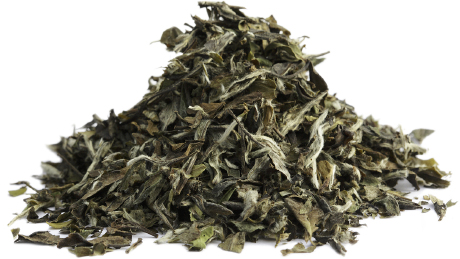
This rare white tea is made from very small buds and a few baby leaves that are picked in the early spring, and once they have been dried, they look like lots of tiny white blossoms with a few darker leaves surrounding the white bud - the reason for it's name, 'White Peony'.
From the Fuijan province, this tea is made from tender new buds that are covered in silvery white hairs and it's name means 'Silver Needles'.
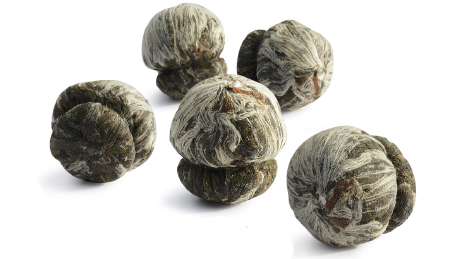
Tuancha, meaning 'tea balls' are made in differing sizes, the smallest is about half the size of a table tennis ball. These little balls are often made from Puerh aged tea and have an earthy flavour and aroma.
Originally from Yunnan province, Tuocha is usually a Puerh tea that has been compressed into a bird's nest shape and has a similar earthy, elemental taste.
China tea which has been dried with Jasmine blossoms placed between the layers of tea. The tea therefore has a light, delicate Jasmine aroma and flavour.
A large-leafed black tea scented with rose petals. The manufacture of 'gongfu' teas demand great skill in the handling of the leaves, the temperature control and the timing of each part of the process.
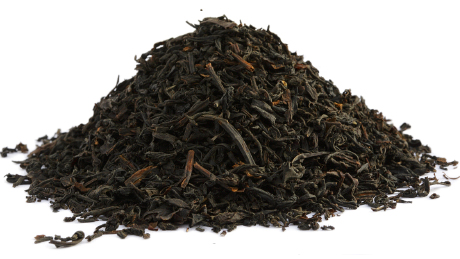
Traditionally, a blend of black China teas treated with natural oils of the citrus Bergamot fruit which gives the tea it's perfumed aroma and flavour. Earl Grey tea is said to have originally been blended for the second Earl Grey by a mandarin after Britain had completed a successful diplomatic mission to China.
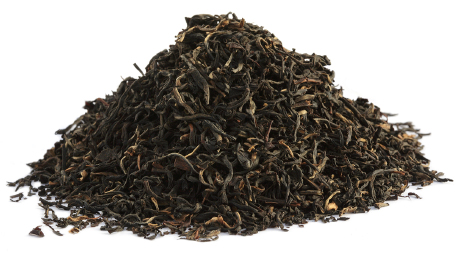
Assam is a major growing area covering the Brahmaputra valley, stretching from the Himalayas down to the Bay of Bengal. There are 655 estates covering some 459,810 hectares. Assam tea has distinctive flecked brown and gold leaves known as "orange" when dried. In flavour it is robust, bright with a smooth, malt pungency and is perfect as the first cup of tea of the day. Such teas are used in everyday popular blends because of the full-bodied richness. There is also an Assam Green tea with an unusual light, almost sweet liquor.
Assam tea bushes start growing in March and the first flush is picked for 8 to 10 weeks, first flush Assams e.g. Bamonpookri, an excellent quality tea with a strong fresh flavour; are rarely marketed in the Europe, unlike first flush Darjeelings.
The plucking of the second flush begins in June with most of the production taking place from July to September. The second flush Assam is the best of the season and when brewed give a rich aroma, a clear dark read liquor and a strong malty taste. Good examples of second flush assams are, Napuk, displaying all the qualities of a well made Assam and Thowra, which has a strong spicy liquor and lots of body.
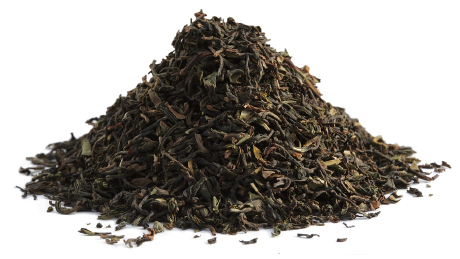
Regarded as the "Champagne of Teas," Darjeeling is grown on 87 estates on the foothills of the Himalayas, on over 18,000 hectares at about 7000 ft. Light and delicate in flavour and aroma, and with undertones of muscatel, Darjeeling is an ideal complement to dinner or afternoon tea. The first "flushes" (pluckings) are thought to produce the best Darjeeling vintage but all crops are of very high quality. Darjeeling Green is rare tea similar to Japanese Sencha with an exquisite aroma and delicate taste.
The Darjeeling bushes' first new shoots - the first flush - are picked in April. These first teas of the season are the finest and are much in demand, fetching incredibly high prices at auction. Castleton First Flush, has a perfect green-brown leaf and is from one of the most prestigious gardens in the area. It gives an exquisite perfume and taste of green muscatel. Bloomfield First Flush is again from a recognised garden and its subtle astringent flavour is typical of Darjeeling first flush.
Second flush Darjeelings are picked between May and June and produce excellent quality teas that are considered by some to be better than the first flush as they have a fruitier, less astringent flavour than the earlier teas. The leaves are darker brown and contain plenty of silvery tip. Again good examples of second flush Darjeelings are, Puttabong, which is one of the better second flush Darjeelings available, with a discernible muscatel flavour and Namring, a fruity balanced taste perfect for afternoon tea.
The Nilgiri region, situated in southern India, forms a high hilly plateau at the conjunction of the Eastern and Western Ghat mountains. More than 20,000 smallholders grow and pluck tea with some 106,850 hectares under cultivation. Most Nilgiri teas are used for blending, but there is a rapidly growing demand for the speciality tea of the area. Nilgiri has a bright amber colour and a refreshing, bright and delicate taste. Nunsch is a typical Nilgiri tea, large-leafed, which gives a fruity, bright and flavourful brew.
A blend of teas from all parts of India, this is often served as afternoon tea or after a meal. It is full-bodied, refreshing and with delicate hints of its regional origins.
Probably the most famous of Ceylon teas, Dimbula is cultivated on estates first planted with tea when their coffee crops failed in 1870. Grown 5000 ft above sea level, all Dimbula teas are light and bright in colour with a crisp strong flavour that leaves the mouth feeling fresh and clean.
Today, it forms part of the high-grown zone of central Sri Lanka which includes Dickoya and Nuwarah Eliya.
This tea has long wiry beautiful leaves that give an exquisite, almost oaky taste and good body and strength.
Uva is a fine flavoured tea grown at altitudes between 2,000ft and 4,000ft above sea level on the eastern slopes of the Central Mountains in Sri Lanka. It has a bright, deep amber colour when brewed, with the brisk and crisp, strong Ceylon flavour. These teas are also used in Ceylon blend and make an ideal morning drink or an after-lunch tea.
This is a copper-coloured infusion with a very smooth, pronounced taste and a wonderful aroma. It is a perfect breakfast or day time tea.
Nuwara teas are light and delicate in character, bright in colour and with a fragrant flavour. Their flavour is heightened when taken with lemon rather than milk.
This tea has a bright brisk flavour and a wonderful perfume, good to drink at any time of day with just a little milk
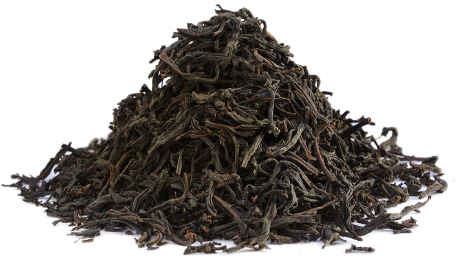
Ceylon teas span the entire spectrum of tea production, from low to high grown teas. By blending teas from different areas of the island, Sri Lanka is able to offer a very wide choice of flavour and characteristics. Some blends are full bodied, others are light and delicate, but all are brisk, full flavoured and have a bright colour.
The most commonly drunk tea in Japan. The dark green flat needles give a pale yellow infusion that has a light delicate flavour.
Gyokuro, which means Precious Dew, is the very best of Japan's teas and is the one chosen to serve to visitors and for special occasions. The leaves are beautiful, flat and pointed emerald needles that give a smooth taste and a subtle perfume, it is a very refined tea. Depending on the quality, the water temperature and length of infusion should be adjusted accordingly.
Traditionally a blend of Assam and Ceylon teas to create a pungent and flavoursome tea to help digest a full english breakfast and give a good brisk start to the day. The essence of early morning tea, or as the Indians call it "bed" tea, is its strength and ability to wake and stimulate the metabolism. Many English Breakfast blends also include tea from Africa to give a coppery brightness to the colour.
A blend of delicate Darjeeling tea and high-grown Ceylon tea to produce a refreshing and light tea, Afternoon Tea also makes an ideal companion to cucumber sandwiches, cream pastries and fruit cake. The essence of Afternoon Tea blends is not their strength but their flavour.
Some tea places offer a 'pot of tea', others have a 'pot of house blend tea'. This tea is equivalent to - if not better than - the type of tea most people buy to use at home. In tea trade language, it is known as a 'popular brand leading blend' . In catering terms it will be a Quality Award tea. It may be a loose leaf or tea bag, either way it's a work of art and can contain 15-35 different teas. These are blended to achieve a consistent quality flavour.
During the year or plucking season, adverse weather conditions can affect the quality of any of the teas. The blender will then have to find other teas that will produce the same flavour and characteristics. To do this they will taste between 200 and 1,000 teas a day and adjust the recipe so we can enjoy our favourite cup of tea all day, everyday.
These are real teas (Camellia sinensis), blended with fruit, spices or herbs. Fruit flavoured tea such as apple or blackcurrant, is real tea blended with fruit peel or treated with the natural fruit juice or oil known as zest. Spiced and herb teas, such as cinnamon, nutmeg or mint, are also real teas blended with spice or herb. Tisanes such as Camomile, Peppermint or Nettle, or the misnamed "fruit teas", do not contain one leaf of real tea.
One of the latest emerging trends in the tea market is bubble tea. This drink originated in Taiwan over 10 years ago and is also known as Tapioca Tea, Pearl Tea, Milk Tea, Booboo, Hen Zhu NIA Cha and variations on these names. The two main ingredients of this cold beverage are tapioca balls and milk tea. Several varieties exist and can include exotic fruit flavourings such as Papaya, Honeydew and Taro as well as ice cream, but the "bubble" comes from the round, gummy tapioca balls that are boiled in the tea flavourings. Kids in Taiwan call these balls "QQ" which means 'chewy' in Chinese, in the West they are, the popular term is "booboo" which is slang for female breasts.
In the past few years, Bubble Tea has become increasingly fashionable in areas such as New York, Los Angeles, Seattle, Vancouver and the Bay area where it is drunk with large colourful straws.
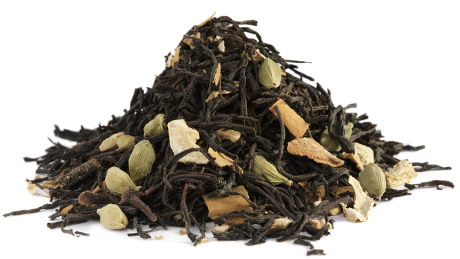
'Chai', (pronounced as a single syllable and rhymes with 'pie') is the word for tea in many parts of the world. It is a centuries-old beverage that has played an important role in many cultures. Chai, from India is basically spiced milky tea and is becoming increasingly popular all over the world. In the United States Chai has caught on and is being sold as, 'Tea Latte' a popular alternative to its coffee namesake. It is generally made up of rich black tea, heavy milk, a combination of spices and some form of sweetener. In traditional Indian recipes the spices vary from region to region but the most common are, cardamom, cinnamon, ginger, cloves and pepper.
Iced Tea was first drunk at the 1904 World Trade Fair in St Louis where the extremely hot weather and demand for cold drinks led Englishman, Richard Blechynden to pour tea into glasses filled with ice cubes.
More than 80 % of all the tea consumed in the US is served as iced tea. So, already a very popular beverage oversees, it is now becoming more popular in the UK. Iced Tea in Europe is one of the fastest growing soft drinks segments, with consumption tripling over the last ten years. To brew iced tea either Ceylon or China Keemun will show the best results.